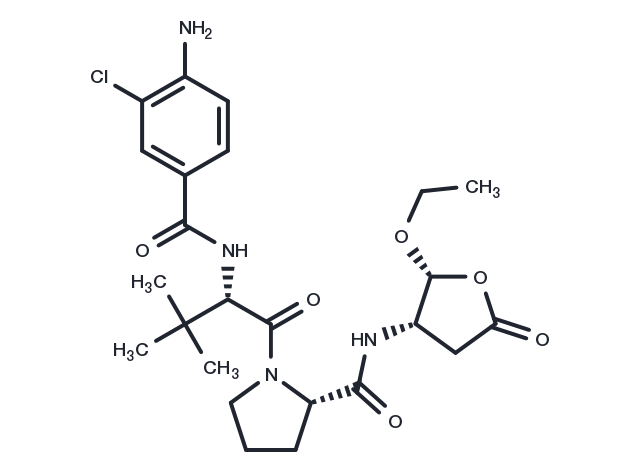Powder: -20°C for 3 years | In solvent: -80°C for 1 year


Belnacasan (VX-765) is an orally active IL-converting enzyme/caspase-1 inhibitor.

| Pack Size | Availability | Price/USD | Quantity |
|---|---|---|---|
| 2 mg | In stock | $ 31.00 | |
| 5 mg | In stock | $ 46.00 | |
| 10 mg | In stock | $ 78.00 | |
| 25 mg | In stock | $ 173.00 | |
| 50 mg | In stock | $ 247.00 | |
| 100 mg | In stock | $ 441.00 | |
| 200 mg | In stock | $ 649.00 | |
| 1 mL * 10 mM (in DMSO) | In stock | $ 51.00 |






| Description | Belnacasan (VX-765) is an orally active IL-converting enzyme/caspase-1 inhibitor. |
| Targets&IC50 | Caspase-1:0.8 nM(Ki), Caspase-4:<0.6 nM(Ki) |
| In vitro | VX-765 demonstrates antiepileptic properties by preventing the increase of IL-1β in the forebrain astrocytes of rats, thereby inhibiting the occurrence of epilepsy without significantly affecting the duration of post-discharge. In adult rats with genetic absence epilepsy, a 3-day administration of VX-765 significantly reduces the cumulative duration and decreases the average spike-wave discharges by 55% through the selective blockade of IL-1β biosynthesis. In acute epileptic mouse models, doses ranging from 50 mg/kg to 200 mg/kg of VX-765 delay the onset of the first epileptic episode and reduce the average number of seizures by 50% and the total duration by 64%. Additionally, a 200 mg/kg dose in a collagen-induced arthritis mouse model suppresses 60% of lipopolysaccharide-induced IL-1β production and leads to a dose-dependent significant reduction in inflammation scores, effectively protecting against joint lesions. |
| In vivo | VRT-043198 inhibits the release of IL-1β from peripheral blood mononuclear cells (PBMCs) and whole blood, with IC50 values of 0.67 μM and 1.9 μM, respectively. VX-765, an orally bioavailable prodrug of VRT-043198, demonstrates potent inhibition of ICE/caspase-1 and caspase-4, with Ki values of 0.8 nM and <0.6 nM, respectively. |
| Kinase Assay | Enzyme inhibition is assayed by tracking of the rate of hydrolysis of an appropriate substrate labeled with either p-nitroaniline or aminomethyl coumarin (AMC) as follows: ICE/caspase-1, suc-YVAD-p-nitroanilide; caspase-4, Ac-WEHD-AMC; caspase-6, Ac-VEID-AMC; caspase-3, -7, -8, and -9, Ac-DEVD-AMC; and granzyme B, Ac-IEPD-AMC. Enzymes and substrates are incubated in a reaction buffer [10 mM Tris, pH 7.5, 0.1% (w/v) CHAPS, 1 mM dithiothreitol, and 5% (v/v) DMSO] for 10 min at 37°C. Glycerol is added to the buffer at 8% (v/v) for caspase-3, -6, and -9 and granzyme B to improve stability of enzymes. The rate of substrate hydrolysis is monitored using a fluorometer. Assays for cathepsin B and trypsin are performed[2]. |
| Cell Research | VX-765 is solubilized in DMSO and stored, and then diluted with RPMI 1640 complete medium (DMSO 0.2%) before use[1]. A total of 2×105 cells/well (100 μL cell suspension) is distributed in triplicate in flat-bottom 96-well plates. Either 50 μL of VX-765 (40 μM in RPMI 1640 complete medium containing 0.2% DMSO) or vehicle control is added to appropriate wells. Following a 30-min incubation at 37°C, 50 μL of LPS diluted in RPMI 1640 complete medium is added at final concentrations varying from 0.001 to 10 ng/mL. Cells are returned to a 37°C incubator. At 4 h after LPS addition, 75 μL of supernatant is removed from wells, cleared by centrifugation for 5 min at 1500 rpm, and stored at 4°C until assayed. Cells are returned to a 37°C incubator until 24 h after LPS addition, at which time 100 μL of supernatant is removed, cleared by centrifugation, and stored at 4°C. Supernatants are tested using ELISA kits for IL-1β, IL-6, IL-18, and IL-1α[1]. |
| Synonyms | VX-765 |
| Molecular Weight | 508.99 |
| Formula | C24H33ClN4O6 |
| CAS No. | 273404-37-8 |
Powder: -20°C for 3 years | In solvent: -80°C for 1 year
Ethanol: 93 mg/mL (182.7 mM)
DMSO: 93 mg/mL (182.7 mM)
You can also refer to dose conversion for different animals. More
bottom
Please see Inhibitor Handling Instructions for more frequently ask questions. Topics include: how to prepare stock solutions, how to store products, and cautions on cell-based assays & animal experiments, etc.
Belnacasan 273404-37-8 Apoptosis Proteases/Proteasome Caspase Inhibitor VX 765 VX765 inhibit VX-765 inhibitor
